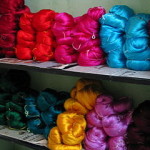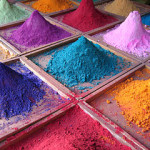 At Patra we pride ourselves in doing things properly – and in the world of dyes one method stands head and shoulders above the rest. Yarn dyeing produces a greater depth of colour and a far superior fabric. Our yarn dyed silks and cottons make a finished result that is not only vibrant, but strong and long-lasting.
At Patra we pride ourselves in doing things properly – and in the world of dyes one method stands head and shoulders above the rest. Yarn dyeing produces a greater depth of colour and a far superior fabric. Our yarn dyed silks and cottons make a finished result that is not only vibrant, but strong and long-lasting.
What is yarn dyeing?
The majority of fabrics sold today are piece dyed, where a textile sheet is woven before the dyeing takes place. Yarn dyeing involves the individual threads being dyed before they are woven. This means that there are no raw edges, the cloth holds its colour better and it is ideal for patterned fabric such a plaid or gingham.
Our yarn dyed garments, such as our new Cotton Seersucker Trousers, are far more complex to make than simply printing stripes but the results are worth it.
The history of dyeing
The earliest evidence of dyeing dates back to Neolithic times and originates from the Anatolian peninsula. China has been using natural dyes, from plants and insects for over 5,000 years. Synthetic dyes have only been around since the 19th century, and the first of these – Mauveine – was discovered accidentally by the English Chemist William Perkins.
Until the mid 1800s all coloured textiles were yarn dyed and then woven. But in 1849 in the French city of Lyon a new dyeing method became popular – piece dyeing. This industrial process didn’t take off at first and remained quite specific to that region of France. But it was this method that would change the textile industry and be adopted all over the globe.
The dyeing process
Today the most common form of colouring fabric is piece dyeing. This involves plain fabric being dipped into a bath of dye, then fixed on a jig to hold the colour fast before being washed and dried. However, despite being the way the majority of fabrics are dyed, we don’t think it’s the best.
Yarn dyeing is far older but works better because the dye penetrates deep into the yarn, completely enveloping it. There are three methods of yarn dyeing – package, warp-beam and skein.
A package is another word for a spool of yarn. The untreated threads are wound around tubes and then placed in a dyeing machine, inside which dye flows, coating the packages. Warp-beam dyeing is similar to package dyeing but on a much larger scale. Here the whole warp is wound around a tube to make one enormous reel of thread, which is the placed into a beam dyeing machine.
A skein, or hank, is a large length (usually around 800 yards) of yarn that has been loosely wound into a ring and then twisted into a figure of eight. These hanks are immersed into dye vats. Package and warp-beam dyeing are more economical but skein-dyed yarns produce a softer and superior thread.
At Patra our yarn is in skeins and is vat dyed to produce thread that ‘glows’ and enables us to make garments of exceptional quality. Silk’s molecular structure results in an ideal yarn substrate for a wide range of dye colours and dye retention, a boom to our design team who hand dye small pieces of silk to achieve just the right colour we are looking for when we prepare our colour palette.
Colour care
After we’ve put in so much to produce fabulous fabric it’s a good idea to keep those colours true and bright, especially for silk. Here are some simply tips to keep your garments looking great.
* Choose a low-temperature, gentle cycle, and use the time-reduction setting if your washing machine offers it.
* Turn your garments inside out to protect the outer surface that people see.
* Do separate out your strong colours from your whites and neutrals
* Don’t tumble-dry – use a gentle, low speed spin cycle and if they’re still wet, roll up in a clean towel to press out excess water and then air-dry
Read our blog on this subject for more hints on caring for silk and protecting colour.
 Taking pride in our production
Taking pride in our production
We are proud of our yarn dyed fabric and of the fact that we have chosen quality over cost. This dyeing method gives an end product that speaks for itself – fabric that’s been coloured and woven with care and craftsmanship. Our stripped cotton is unique, not mass-produced, and our pure silks shimmer with luminous depth.



